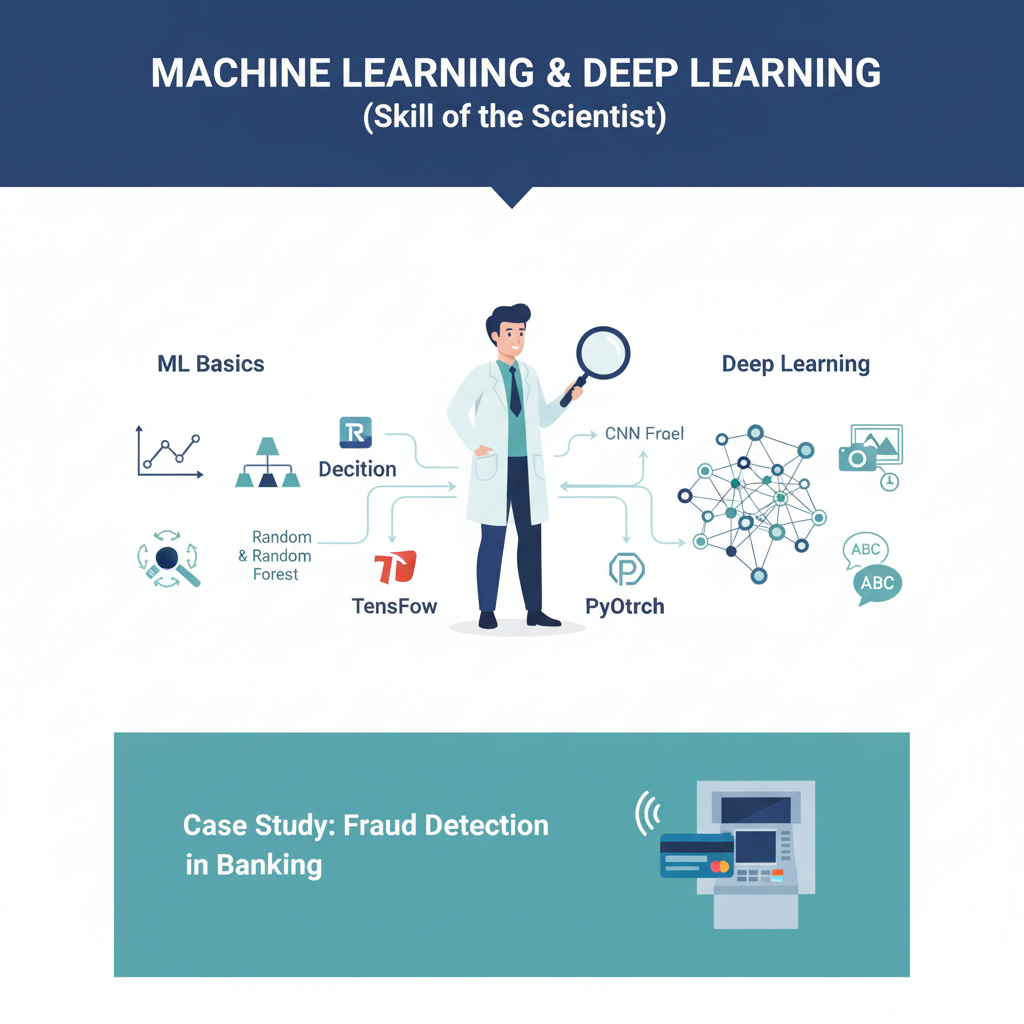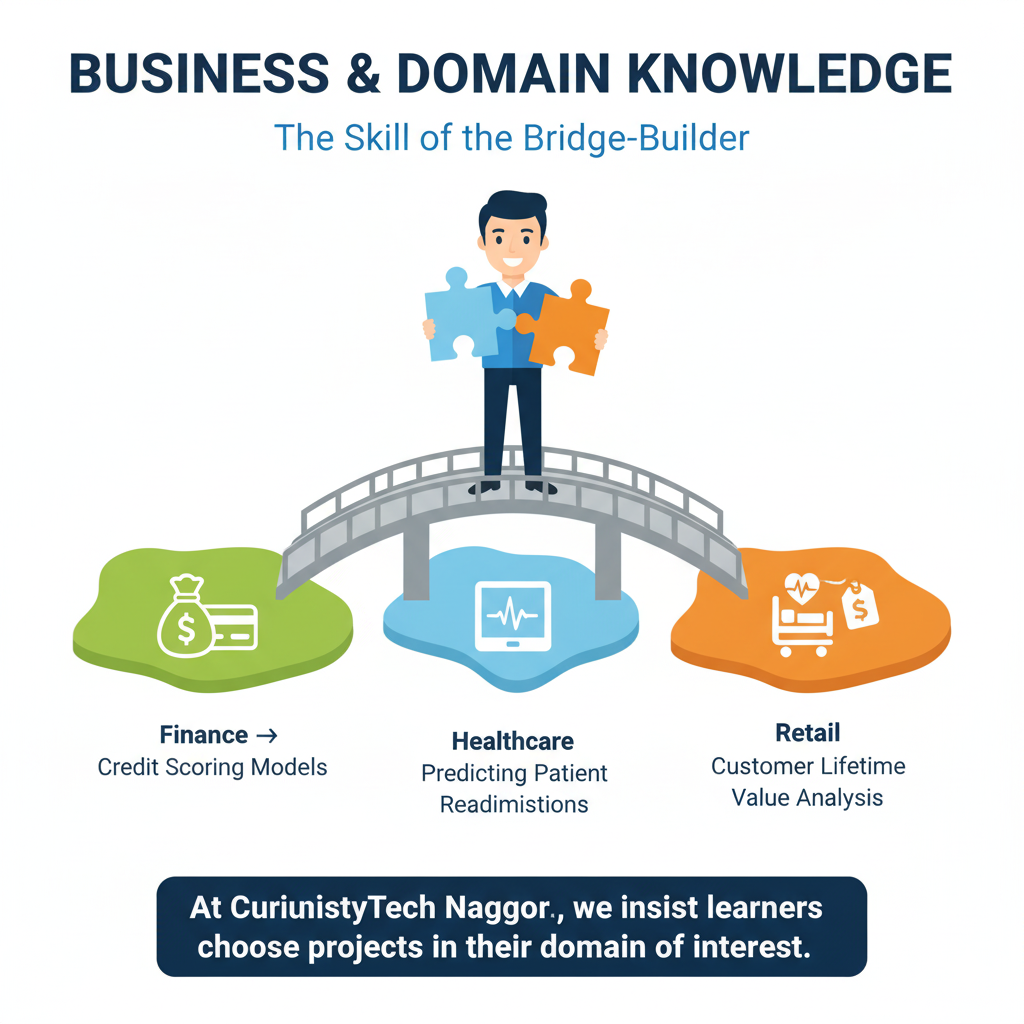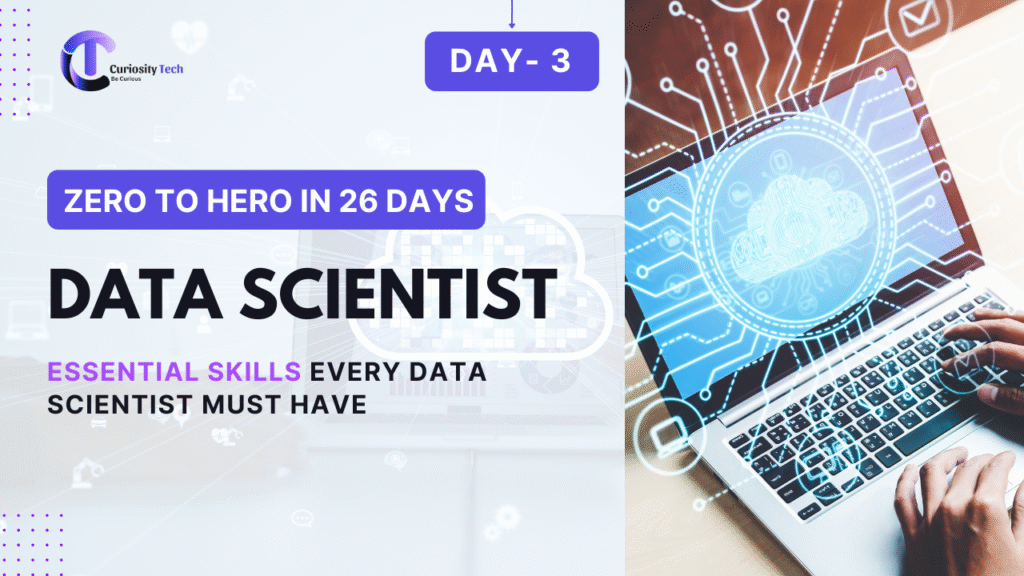Preface
Data Science is not a buzzword anymore—it’s a career path shaping industries. But here’s a truth that CuriosityTech.in mentors in Nagpur (1st Floor, Plot No 81, Wardha Rd, Gajanan Nagar) emphasize with every learner: not every skill is equally important. Some skills are foundational, some are specialized, and others are accelerators that help you stand out.
This blog serves as a comprehensive manual for mastering the must-have skills in 2025 to become a successful data scientist.
Section 1 – Core Foundations (Non-Negotiable Skills)
These are the roots of your data science tree. Without them, no matter how many fancy tools you know, your work won’t hold up.
- Mathematics & Statistics
- Probability distributions
- Hypothesis testing
- Linear algebra
- Regression analysis
- Probability distributions
- Why: Every ML model rests on mathematical theory. Example: Logistic Regression requires understanding sigmoid functions.
- Programming (Python + R)
- Python → Pandas, NumPy, Matplotlib, Seaborn, Scikit-learn
- R → Tidyverse, ggplot2, caret
- Python → Pandas, NumPy, Matplotlib, Seaborn, Scikit-learn
- Why: Python handles scalability, while R handles statistical modeling.
- SQL & Databases
- Writing queries
- Joins, indexing, aggregation
- Handling big datasets
- Why: A data scientist cannot survive without pulling data from relational systems.
- Writing queries
Section 2 – Data Handling & Preparation (Skill of the Craftsman)
A dirty dataset ruins everything. According to a Gartner report (2024), 70% of a data scientist’s time is spent cleaning data.
- Data Wrangling Tools: Pandas, Dplyr (R), OpenRefine
- Techniques: Missing value imputation, outlier detection, normalization
- Example: Preparing customer transaction logs with millions of missing fields for credit risk analysis
Section 3 – Exploratory Data Analysis (Skill of the Detective)
EDA is where insights begin.
- Visualization Tools: Matplotlib, Seaborn, Plotly, ggplot2
- Techniques: Histograms, correlation heatmaps, pair plots
- Goal: Identify hidden patterns, anomalies, relationships before modeling
Story Example: At CuriosityTech, during a project with an FMCG company, simple EDA revealed that one product line contributed 60% of revenue, leading to an entire marketing strategy pivot.
Section 4 – Machine Learning & Deep Learning (Skill of the Scientist)
In 2025, AI isn’t optional—it’s expected.
- ML Basics: Linear regression, Decision Trees, Random Forest, SVM
- Deep Learning: Neural networks, CNNs for images, RNNs for text
- Frameworks: TensorFlow, Keras, PyTorch
Case Study: Fraud detection in banking → ML models predict unusual transactions; DL models scan facial recognition at ATMs.

Section 5 – Business & Domain Knowledge (Skill of the Bridge-Builder)
A great model without business context = useless.
- Finance → Credit scoring models
- Healthcare → Predicting patient readmissions
- Retail → Customer lifetime value analysis
At CuriosityTech Nagpur, we insist learners choose projects in their domain of interest. It builds credibility when applying for jobs.

Section 6 – Communication & Storytelling (Skill of the Influencer)
You don’t just present numbers—you tell stories.
- Tools: Tableau, Power BI, Google Data Studio
- Techniques: Data storytelling frameworks like “Problem → Insight → Recommendation”
- Example: Instead of saying “sales dropped 15%”, a data scientist should say “Sales dropped 15% because online ads weren’t optimized for mobile users. Investing 20% more in mobile marketing could recover losses.”
Section 7 – Emerging Skills for 2025 (Skill of the Future)
The data world evolves rapidly. Here are must-watch areas:
- MLOps: Model deployment with Docker, Kubernetes, CI/CD pipelines
- Generative AI: Using large language models (LLMs) in workflows
- Data Ethics: Fairness, accountability, transparency (essential with India’s DPDP Act)
- Cloud Platforms: AWS SageMaker, Azure ML, GCP Vertex AI
Skill Matrix (Priority Ranking)
| Skill Area | Importance in 2025 | Learning Difficulty | Career Impact |
| Statistics & Math | Very High | Medium | Long-term |
| Python Programming | Very High | Easy-Medium | High |
| SQL & Databases | High | Easy | Medium |
| EDA & Visualization | High | Medium | High |
| Machine Learning | Very High | Hard | Very High |
| Deep Learning | Medium-High | Hard | Specialized |
| Business Domain Knowledge | High | Varies | Very High |
| Communication Skills | Very High | Medium | Long-term |
| MLOps & Cloud | Medium-High | Hard | High |
| Data Ethics | Medium | Easy-Medium | Mandatory |
Hierarchical Diagram (described)
Imagine a tree diagram:
- Root (Foundation): Math, Statistics, Programming
- Trunk (Core): Data Wrangling, SQL, EDA
- Branches (Growth): Machine Learning, Deep Learning, Visualization
- Leaves (Outcome): Business insights, deployed AI systems
- Fruit (Impact): Career success, business transformation
How to Master These Skills (Action Plan)
- First 3 Months: Python, SQL, Stats basics
- Next 3 Months: Data Wrangling, Visualization, Mini projects
- Next 6 Months: Machine Learning, Business case studies
- Next 3 Months: Specialization (Deep Learning, NLP, Big Data)
- Continuous: Communication, domain expertise, ethical practices
At CuriosityTech.in, we structure training programs around this roadmap, blending theory with hands-on industry projects. Learners also receive mock interview prep, mentorship, and career counseling. Call us at +91-9860555369 to explore live batches.
Conclusion
The role of a data scientist in 2025 is multi-dimensional. It’s not just about coding or crunching data—it’s about being a problem solver, storyteller, and ethical innovator.
By focusing on core foundations, applied projects, and future skills like MLOps and generative AI, you can stay 10 steps ahead of the market. And with expert guidance from CuriosityTech Nagpur, learners transform from beginners into professionals ready to tackle global challenges.

